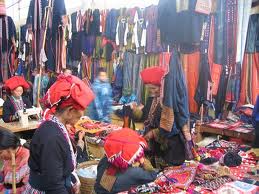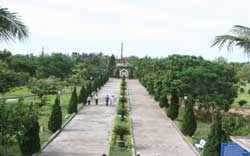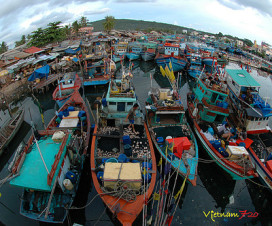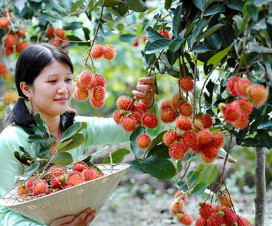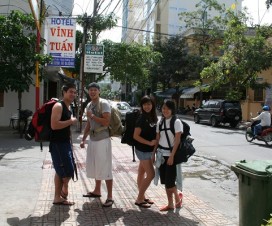My friend said that it would be a pity if you travelled to the northwest mountains of Vietnam without stopping off at Sin Ho market. I didn’t give his claim much credence at first, until I stepped foot into the market—known as Cho huyen Sin Ho, and open every Sunday.
Ethnic market in the North of Vietnam
Situated imposingly on the Sin Ho plateau of Lai Chau province, Sin Ho town is located on the highest peak, over 2,000 metres higher than sea level and surrounded by verdant mountain ranges and clouds.
Locals call it: The Roof of Lai Chau province. The small town is also well-known as the second Sapa of the northwest area. But the climate in Sin Ho is even more sour and scornful than that of Sapa. Suddenly, you can be standing in a sea of white clouds, then, just several minutes later, the rain will rumble down like a waterfall. But right after the last rain drop falls, the sun will rise brilliantly and a cool wind will blow over the small town.
It takes me four hours to drive up the zigzagging road from Phong Tho town, at the junction between National Road No. 4D from Sapa and National Road No.12 towards Muong Lay town. The mountain road has been smoothly paved over, but it’s still a slow and winding drive. Consequently, I choose to spend a night at Sin Ho town and wait for the market until the next morning.
In the late afternoon, Sin Ho town looks small, deserted and gloomy, with unadorned and sparse wooden houses roofed with dark grey cement tiles and only a few shops and restaurants. It’s lucky that there are several modern guesthouses and mini hotels with reasonable prices. For only VND250, 000 per twin room, I check into the Thanh Binh guesthouse. It’s not an overstatement to say that at such a cost, this is the best hotel outside of Sapa in the northwestern area. It has spacious rooms, excellent facilities and a friendly personnel.
On Sunday morning, the sleepy town comes alive. From all paths up and down leading to the town centre, waves of tribes people walk or ride horses and motorbikes, all loaded with many kinds of farm products, toward the market. These tribes come from many unsociable villages up and down the mountains. They are Flower Hmong, Blue Hmong, Black Hmong, Lu, Black Dao and Red Dao, amongst others.
After a morning at the market, I take a trekking tour to Pha Xo Lin II village, just three kilometres from the town centre. The village is home to the Dao Khau tribe, also known as the Sewing Dao, or the Black Dao, who wear black trousers richly embroidered with signature flower, tree and star patterns seen on many Dao costumes. They also wear a front hanging black apron with a wide, plain blue band around its outside, together with a plain black turban.
The village is very gorgeous and poetic, with dark wooden houses roofed with black marble tiles and fenced in with marble hedges. This season, the peach and mango orchards are ripening in a riot of red and yellow. It’s mouthwatering to walk in the village, where you can take a seat under the fruit trees to delight in lovely lanterns swinging in the cool winds and their fresh and sweet tastes. Pha Xo Lin village is very well-known for its special golden red mangoes, with their sweet taste and jackfruit-like flavour.
Besides its tasty fruits, Pha Xo Lin village is a shopping paradise of brocades and embroidery products. It’s common to see Dao women sitting at their thresholds in their front yards or under the fruit trees sewing passionately. While you’re there, don’t miss out on buying some clothes, scarves or other decorous things from the tribes people. Their products are very refined and gorgeous, as befitting of their name—the Sewing Dao tribe.
Source: Timeout

